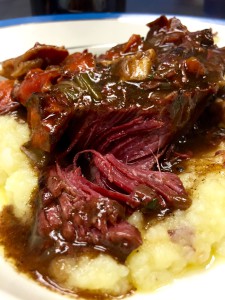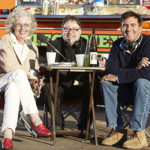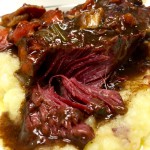
Imagine a round of beef sitting in two bottles of rich Barolo wine, roasting away in your oven, its aromas seducing you no matter where you walk in the house… this is pleasure land. That beef, when it’s done, will be fork tender, almost melting into a sauce that looks like red velvet.
To say we bayed at the moon when we ate it is only slightly exaggeratory. We did keel over when we made and devoured this in the studio, and drank glasses of Barolo.
This isn’t a hard recipe; you brown the outside of the meat a little to bring out its flavor, then submerge it halfway in the wine. It’s wildly good.
— Faith Middleton
 ON-DEMAND: Listen to Faith and the gang rave about Lidia’s Beef Roasted in Barolo Wine recipe during an episode of The Faith Middleton Food Schmooze®. And, subscribe to the podcast so you never miss a drop of pleasure.
ON-DEMAND: Listen to Faith and the gang rave about Lidia’s Beef Roasted in Barolo Wine recipe during an episode of The Faith Middleton Food Schmooze®. And, subscribe to the podcast so you never miss a drop of pleasure.
Want more Lidia? Listen to Faith’s conversation with Lidia about her new memoir, My American Dream.
- 5 pound boneless beef-roast (flat-iron, chuck, or bottom round), trimmed of fat
- 2 teaspoons kosher salt plus more to taste
- 1/3 cup extra virgin olive oil
- 2 medium onions 1 pound total, quartered
- 3 carrots large, peeled and cut into 2-inch chunks
- 4 stalks celery cut into 2-inch chunks
- 6 cloves garlic plump, crushed and peeled
- 2 sprigs rosemary fresh
- 6 sage leaves large, fresh
- 1/4 teaspoon nutmeg freshly grated
- 1 teaspoon black peppercorns
- 1 cup porcini mushrooms dried, loosely packed, rinsed
- 2 bottles Barolo wine 750 milliliters each
- 2 cups beef stock or as needed (see note below)
- black pepper freshly ground
- Preheat the oven to 250° F. Season the roast with half the salt. Heat the olive oil in a large Dutch oven set over medium-high heat. Brown the roast on all sides, about 8 minutes in all, then remove it to a platter.
- Add the onions, carrots, celery, and garlic, and cook until the onions begin to wilt, about 6 minutes. Add the rosemary, sage leaves, grated nutmeg, peppercorns, dried porcini, and remaining teaspoon salt, and toss all together. Cook for 3 or 4 minutes, just until the vegetables soften, stirring frequently and scraping up the browned meat bits on the pan bottom; then lower the heat.
- Push the vegetables to the side, and return the seared roast to the cleared side of the pan. Pour in the bottles of wine and any meat juices that collected on the platter. The roast should be at least half submerged, so add beef stock as needed.
- Cover the pot, and heat until the wine is steaming but not boiling. Uncover the pan, and place it in the oven. After 30 minutes, rotate the roast so the exposed meat is submerged in the braising liquid. Braise this way, turning the meat in the pan every 30 minutes, for about 3 hours, until the meat is fork-tender. The liquid should not boil; if it does, pour in some cold water to stop the bubbling, and lower the oven temperature.
- After about 2½ hours or so, check the beef. If it is easily pierced with a fork, take the pan from the oven. Remove the meat to a platter, with the carrots and celery. Skim any fat from the braising juices, heat them to a boil, and reduce until the sauce coats the back of a spoon. Pour it through a sieve set over a clean container. Press the juices well from the strained herbs and remaining vegetable pieces. Pour in any juices from the meat platter, and season the sauce to taste with salt and freshly ground black pepper. (If you are not going to serve it right away, put the meat and reserved vegetables in the sauce to rest and cool, for a couple of hours or overnight.)
- To serve: Slice the meat crosswise (easiest when it is cool). Pour a shallow layer of sauce into a wide skillet, and lay the slices in, overlapping. Heat the sauce to bubbling, spooning it over the beef, so the slices are lightly coated. Lift them with a broad spatula, and slide them onto a warm platter, fanned out. Heat the carrots and celery in the sauce, too, and arrange them on the platter. Serve, passing more heated sauce at the table.
*Lidia uses her own Mixed Meat Stock, which can be found on page 144 of her cookbook Lidia's Mastering the Art of Italian Cuisine. We used a good quality beef stock.


